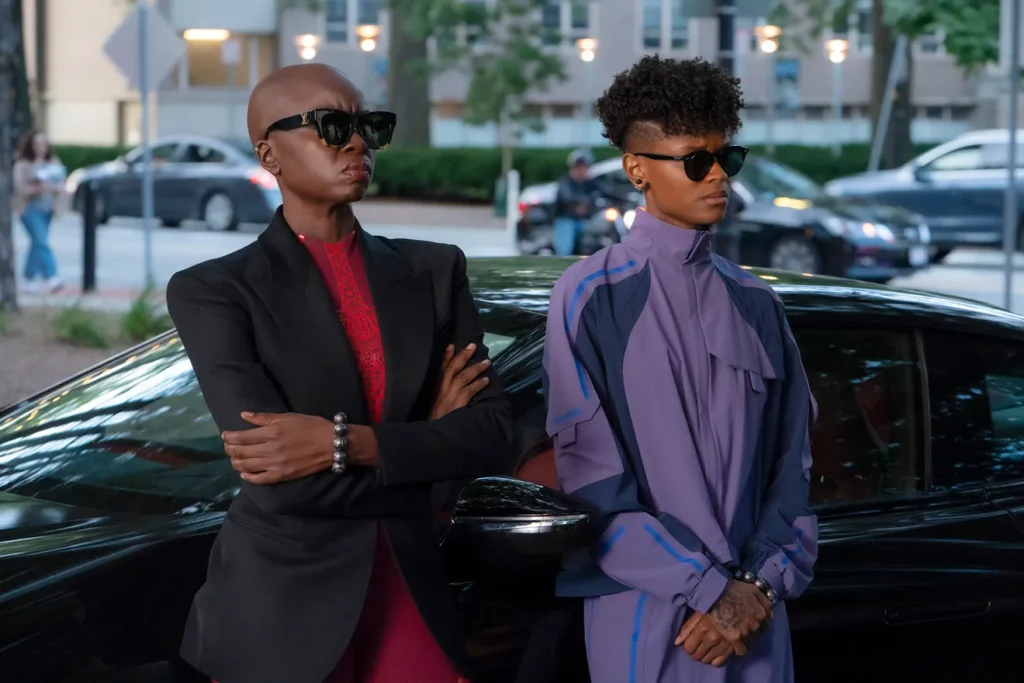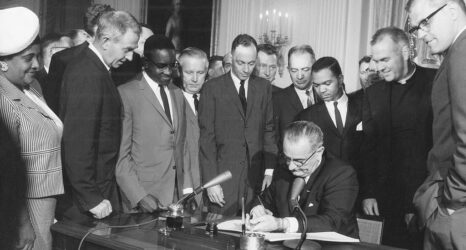
MIT rarely allows Hollywood films to be shot on their campus. So it was a surprise when an email went out in 2021, alerting students that a film titled Summer Break would be filming at the school. Turns out, this was the working title of Black Panther: Wakanda Forever. It’s now burst into theaters, with its rare commodity of MIT as a backdrop.
But something else was special about Wakanda Forever’s filming location. The MIT scenes were shot a stone’s throw from where, a century before, Pauline Elizabeth Hopkins worked at the Institute.
Pauline Elizabeth Hopkins was a groundbreaking novelist, playwright, performer, orator, thinker and activist—and she’s credited with inventing the setting that eventually became Wakanda in her science fiction. But while her imaginative creations live on in massive-franchise form, her name isn’t widely known.
This tremendous literary and political figure is memorialized sparsely: a small placard stands outside her former North Cambridge home, where she lived until her death in 1930. The Pauline Elizabeth Hopkins Society—founded in 2009—continues to uphold her legacy through scholarship, publications and conference events. But there are no records of her in MIT’s archives—though there are numerous contemporary accounts of her working at the school, she seems to have vanished quietly and undeservedly from Institute memory as much as from public acclaim.
Deeply enmeshed in the intellectual and activist community around Beacon Hill in the end of the 19th and beginning of the 20th centuries, Hopkins was a groundbreaker from the time she was a teen as a playwright and performer.

Born in 1859 in Portland, Maine, she moved to Boston at a young age and remained in Massachusetts for most of her life. Lois Brown writes that her family had a long history of racial activism, which she explores at length in her excellent biography of Hopkins, Pauline Elizabeth Hopkins: Black Daughter of the Revolution (the title is drawn from a speech that Hopkins gave at Boston’s Faneuil Hall in 1905).
She was a graduate of Girls’ High School—“a venerable Boston institution founded in the early 1850s that, despite considerable opposition from families and even family physicians who ‘strongly advised’ against certain advanced courses of studies for girls, placed graduates in leading American colleges.” Also among the alumnae of Girls’ High School was Marcella O’Grady Boveri—the first woman to graduate from MIT.
Hopkins’ career, in a nutshell, can be understood in three portions: In the first, she was a successful playwright and performer, with her first original 1879 production of Peculiar Sam, or The Underground Railroad which Brown writes, “provided American audiences with the first staged reenactments of slavery that were not offered through the lens of the white imagination.”
After that, her writing and speaking engagements, for audiences of all races, broadly encompassed a number of contemporary social issues, including speaking boldly about racial violence and the Haitian Revolution.
The second portion of her career unfolded with her stewardship of Colored American Magazine. It’s in this second portion that she produced the work she is now best known for. As a writer and editor for Colored American Magazine, the widest circulating Black periodical prior to Crisis, Hopkins established herself. Her first novel, Contending Forces, was serialized through the magazine, followed by her three other novels that cemented her as not only a powerful activist and intellectual but also as a pioneering writer.
These novels have been dubbed “firsts” by a Black author in their genre: Hagar’s Daughter, her second book, has been called the first entry by a Black writer into the popular “detective” genre of fiction.
But it was her fourth and final novel, Of One Blood; Or, The Hidden Self, serialized over the course of 1902-03, that resonated across the next century. It would also be called, repeatedly, the first science fiction novel by a woman of color.
Of One Blood is premised around the existence of two uncolonized African utopian communities—societies with far advanced artistic and technological achievements. If this sounds familiar, it should. My favorite phrase applied to the kingdoms of Of One Blood is a “proto-Wakanda,” as recently noted by Cherene Sherrard-Johnson. In the novel—not unlike in the plot of the first Black Panther movie—these African utopian societies are questioned about why they retain their secrecy instead of engaging in outreach to support and elevate the oppressed people of the African diaspora.
To call Hopkins a science fiction writer, or a mystery writer, or a romance writer would be a vast oversimplification—akin to calling MIT a good school to go to for math. Hopkins’ fiction innovated in its time with lasting impact. It planted imaginative seeds that sprouted far down the next century of storytelling. That impact is too vast and nuanced to excavate here: it stretches from a foundational use of the ghost story motif to address the horrors of slavery (Of One Blood) to the pioneering use of a romance plot to explore contentious political questions of racial equality (Contending Forces). But while she was a novelist, she was also a journalist, orator, activist and intellectual. In short, she was a powerhouse, an innovator and an intellectual dynamo.
She also famously and publicly opposed Booker T. Washington’s accommodationist approach to contemporary race politics, which was, in short, that Black people in America should not directly challenge the roots of their oppression and instead focus on building economic power and influence. Her passionate opposition to this approach cost her dearly.
To call Hopkins a science fiction writer, or a mystery writer, or a romance writer would be a vast oversimplification—akin to calling MIT a good school to go to for math. Hopkins’ fiction innovated in its time with lasting impact
Booker T. Washington personally cut her rising career short, buying the Colored American Magazine through a front man and dismantling it. This included the purchase of one of Hopkins’ best-known novels, Contending Forces, which had been published through the magazine. Hopkins’ fast-rising star was stopped short, and, as Brown describes, Washington “effectively banished Hopkins and her colleagues from the world of periodical publishing.” All of Hopkins’ novels had been published as periodical installments and all through Colored American Magazine.
Hopkins did not go quietly after her exile. She continued writing, despite obvious demoralization and contributed to several magazines, even founding New Era Magazine in 1916. Hopkins’ career did decline, however, and she supported herself through various stenography jobs around the Cambridge area. Beginning in 1918, that work included time at MIT.
Despite her accomplishments as a powerful and daring public intellectual of her day, Hopkins has largely been lost to obscurity. Notable efforts have been made by Lois Brown, Ann Allen Shockley, Mary Helen Washington, Claudia Tate, Hanna Wallinger, Max L. Chapnick, Henry Louis Gates Jr. and others to restore Hopkins to scholarly attention. But while her works power the imagination of millions of viewers returning to Wakanda in theaters, her legacy in American cultural memory is nowhere near what it should be.
It’s worth noting that the word “stenographer” has been known to cloak the important roles of women in the past, diminishing them from the level of contributor to the image of a notetaking secretary. To take another example from MIT, many of the first coders were the women who actually assembled, entered and fine-tuned code. The software designers of ENIAC were never introduced to the press or credited for their role. In that context, it seems significant that The Baltimore Afro-American’s notice of her death in 1930 included the line “she was still engaged in research work for the Institute of Technology.”
(To read more about Hopkins’ literary legacy in detail, explore this thorough article exploring the recent reissuing of two of Hopkins’ most famous novels.)
While there is a great deal we know about Hopkins’ life, there is much more, especially during her later years, that we don’t. What precisely was the work she did at MIT during the last decade of her life? What projects was she involved in and what was her role? And while the parallels between Of One Blood and Marvel’s Wakanda have been widely noted, there is no direct narrative of how this early 20th-century novel evolved to become part of the 1966 debut of Wakanda in the Marvel comic.
But it is easily recognizable as a near-identical setting with the novel’s themes of outreach versus isolationism at play in the original comics and in the film adaptation. Jack Kirby and Stan Lee (credited with creating the Black Panther character) spoke about myriad inspirational figures behind the character—from Mansa Musa to Marcus Garvey—but not directly about his world. (An oversight which I personally surmise stems from the fact that there were many more minds and hands at work in its creation than Kirby and Lee who were never given the chance to talk about their role.)
That’s a story that is still waiting to be explored. There are plenty of tangled webs of influence and storytelling in the mix.
One theory about where the name “Wakanda” itself comes from is a 1915 movie treatment from Edgar Rice Burroughs, published as a novel in 1957 just a few years before Black Panther’s comic debut. Is that a clue tying the comics’ inspiration back to early 20th century science fiction set in Africa? Or is the link more subtle? Hopkins’ story is far larger than even the legacy of her science fiction, monumental as that legacy is.
In any case, Hopkins’ name is back at MIT—this time, in the curriculum. Professor Marah Gubar of MIT Literature came across Hopkins’ work as she sought to create a more diverse reading list for her students in the course “Science Fiction before Science Fiction” (That is, works that are now called science fiction, but were establishing the genre before that term came into use in the 1930s).
Hopkins’ writing wasn’t anthologized in the collections of science fiction and fantasy published by academic presses that Gubar was consulting at the time, and Gubar recalls that Hopkins’ work had never been assigned to her in undergrad or grad school. It wasn’t until she came across Hopkins’ name in Lisa Kroger and Melanie R. Anderson’s Monster, She Wrote: The Women Who Pioneered Horror and Speculative Fiction that the work of “the single most productive Black woman writer at the turn of the century” was revitalized at the Institute where she spent the last decade of her life.
Up next:
U.S. democracy is at a dangerous inflection point—from the demise of abortion rights, to a lack of pay equity and parental leave, to skyrocketing maternal mortality, and attacks on trans health. Left unchecked, these crises will lead to wider gaps in political participation and representation. For 50 years, Ms. has been forging feminist journalism—reporting, rebelling and truth-telling from the front-lines, championing the Equal Rights Amendment, and centering the stories of those most impacted. With all that’s at stake for equality, we are redoubling our commitment for the next 50 years. In turn, we need your help, Support Ms. today with a donation—any amount that is meaningful to you. For as little as $5 each month, you’ll receive the print magazine along with our e-newsletters, action alerts, and invitations to Ms. Studios events and podcasts. We are grateful for your loyalty and ferocity.





